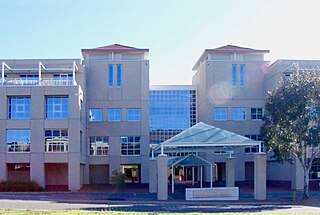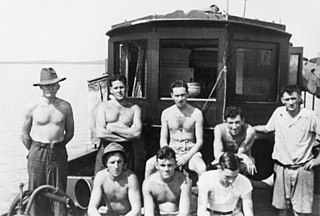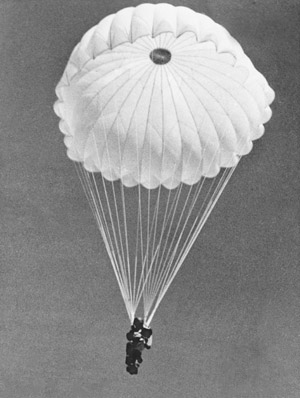Special Operations Executive (SOE) was a British organisation formed in 1940 to conduct espionage, sabotage and reconnaissance in German-occupied Europe and to aid local resistance movements during World War II.

The Australian Secret Intelligence Service is the foreign intelligence agency of Australia, tasked with the covert collection of information overseas through personal contacts and other means of human intelligence. It is part of the Australian Intelligence Community and is also responsible for counter-intelligence and liaising with the intelligence agencies of other countries such as the NZSIS. ASIS was formed in 1952 but its existence remained secret within much of the government until 1972. ASIS is comparable to the American CIA and the British MI6.

The Australian Signals Directorate (ASD), formerly the Defence Signals Directorate (DSD), is the federal statutory agency in the Australian Government responsible for foreign signals intelligence, support to military operations, cyber warfare, and information security. ASD is part of the Australian Intelligence Community. ASD's role within UKUSA Agreement is to monitor signals intelligence ("SIGINT") in South and East Asia. The ASD also houses the Australian Cyber Security Centre.

The Security Service, also known as MI5, is the United Kingdom's domestic counter-intelligence and security agency and is part of its intelligence machinery alongside the Secret Intelligence Service (MI6), Government Communications Headquarters (GCHQ), and Defence Intelligence (DI). MI5 is directed by the Joint Intelligence Committee (JIC), and the service is bound by the Security Service Act 1989. The service is directed to protect British parliamentary democracy and economic interests and to counter terrorism and espionage within the United Kingdom (UK).
The Auxiliary Units, Home Guard Shock Squads or GHQ Auxiliary Units were specially trained, highly secret quasi military units created by the British government during the Second World War with the aim of using irregular warfare in response to a possible invasion of the United Kingdom by Nazi Germany, "Operation Sea Lion". With the advantage of having witnessed the rapid fall of several Continental European nations, the United Kingdom was the only country during the war that was able to create a multilayered guerrilla force in anticipation of an invasion.

South West Pacific Area (SWPA) was the name given to the Allied supreme military command in the South West Pacific Theatre of World War II. It was one of four major Allied commands in the Pacific War. SWPA included the Philippines, Borneo, the Dutch East Indies, East Timor, Australia, the Territories of Papua and New Guinea, and the western part of the Solomon Islands. It primarily consisted of United States and Australian forces, although Dutch, Filipino, British, and other Allied forces also served in the SWPA.

British Security Co-ordination (BSC) was a covert organisation set up in New York City by the British Secret Intelligence Service (MI6) in May 1940 upon the authorisation of the Prime Minister, Winston Churchill.

Z Special Unit was a joint Allied special forces unit formed during the Second World War to operate behind Japanese lines in South East Asia. Predominantly Australian, Z Special Unit was a specialist reconnaissance and sabotage unit that included British, Dutch, New Zealand, Timorese and Indonesian members, predominantly operating on Borneo and the islands of the former Dutch East Indies.
A stay-behind operation is one where a country emplaces secret operatives or organizations in its own territory, for use in case of a later enemy occupation. The stay-behind operatives would then form the basis of a resistance movement, and act as spies from behind enemy lines. Small-scale operations may cover discrete areas, but larger stay-behind operations envisage reacting to the conquest of whole countries.

The Coastwatchers, also known as the Coast Watch Organisation, Combined Field Intelligence Service or Section C, Allied Intelligence Bureau, were Allied military intelligence operatives stationed on remote Pacific islands during World War II to observe enemy movements and rescue stranded Allied personnel. They played a significant role in the Pacific Ocean theatre and South West Pacific theatre, particularly as an early warning network during the Guadalcanal campaign.

Parham Airfield Museum is a museum in Framlingham in Suffolk, England. The airfield was named after the village of Parham in Suffolk famously linked to the Aldeburgh poet George Crabbe.

No. 200 Flight was a Royal Australian Air Force special duties flight of World War II. The flight was formed in February 1945 to support the Allied Intelligence Bureau (AIB) and saw action over Borneo and the Netherlands East Indies (NEI) from March that year until the end of the war in August. No. 200 Flight was disbanded in December 1945.
The Allied Intelligence Bureau (AIB) was a joint United States, Australian, Dutch and British intelligence and special operations agency during World War II. It was responsible for operating parties of spies and commandos behind Japanese lines in order to collect intelligence and conduct guerrilla warfare against Japanese forces in the South West Pacific. The AIB was formed in June 1942 to coordinate the existing Allied propaganda and guerrilla organisations. The first controller of the AIB was Colonel C. G. Roberts. At its peak the AIB contained men from ten individual services and controlled or coordinated eight separate organisations. The role of the AIB was to obtain information about the enemy, "to weaken the enemy by sabotage and destruction of morale and to lend aid and assistance to local effort to the same end in enemy territories." One member of the AIB was Alfred Deakin Brookes, who went on to become the first head of the Australian Secret Intelligence Service in May 1952.
The Far Eastern Liaison Office (FELO) was a Second World War Propaganda and Field Intelligence unit set up under the orders of the Allied Land Commander, General Sir Thomas Blamey, on 19 June 1942. FELO became one of four sections of the Allied Intelligence Bureau (AIB) which was established on 6 July 1942 to control and co-ordinate the activities of various intelligence organisations that had been set up after the outbreak of war with Japan.
Netherlands East Indies Forces Intelligence Service (NEFIS) was a Dutch World War II-era intelligence and special operations unit operating mainly in the Japanese-occupied Netherlands East Indies (now Indonesia).

The Z Experimental Station (ZES) was established in July 1942 at Munro Terrace, Mooroobool, Cairns, Queensland, Australia, jointly by Secret Intelligence Australia and the Inter-Allied Services Department. The building chosen to be the headquarters was known as "Fairview", and it had been the home of Richard Ash Kingsford, the first mayor of Cairns and grandfather of aviator Sir Charles Kingsford Smith.
The Allied Translator and Interpreter Section (ATIS), also known as the Allied Translator and Interpreter Service or Allied Translator and Intelligence Service, was a joint Australian/American World War II intelligence agency which served as a centralized allied intelligence unit for the translation of intercepted Japanese communications, interrogations and negotiations in the Pacific Theater of Operations between September 1942 and December 1945. During the last few months of operation ATIS primarily focused on investigation of Japanese war crimes. The section was officially disbanded on April 30, 1946.

The Secret Intelligence Service (SIS), commonly known as MI6, is the foreign intelligence service of the United Kingdom, tasked mainly with the covert overseas collection and analysis of human intelligence on foreign nationals in support of its Five Eyes partners. SIS is one of the British intelligence agencies and the Chief of the Secret Intelligence Service ("C") is directly accountable to the Foreign Secretary.
The Government of the United Kingdom maintains several intelligence agencies that deal with secret intelligence. These agencies are responsible for collecting, analysing and exploiting foreign and domestic intelligence, providing military intelligence, and performing espionage and counter-espionage. Their intelligence assessments contribute to the conduct of the foreign relations of the United Kingdom, maintaining the national security of the United Kingdom, military planning, public safety, and law enforcement in the United Kingdom. The four main agencies are the Secret Intelligence Service, the Security Service (MI5), the Government Communications Headquarters (GCHQ) and Defence Intelligence (DI). The agencies are organised under three government departments, the Foreign Office, the Home Office and the Ministry of Defence.

Operation Semut was a series of reconnaissance operations carried out by Australia's Z Special Unit in 1945, during the final stages of World War II. This operation was the part of the Borneo Campaign, and was undertaken in Sarawak, northwestern Borneo, in support of Allied operations to secure North Borneo. Another closely related operation codenamed Agas was carried out concurrently in North Borneo. Both operations combined and relayed their intelligence through the Stallion Project to Australian forces and carried out guerrilla warfare against the Japanese in the region with the full support of the local population. A total of four operations were undertaken under the auspices of Operation Semut, concluding in September and October 1945.










